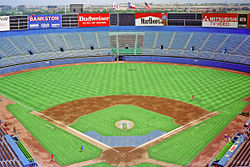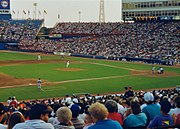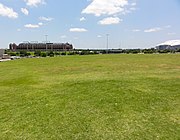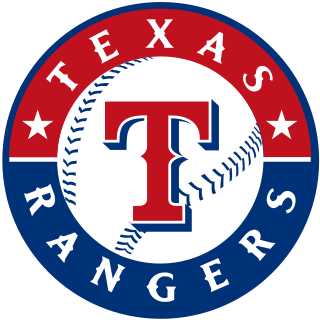
The Texas Rangers are an American professional baseball team based in the Dallas–Fort Worth metroplex. The Rangers compete in Major League Baseball (MLB) as a member club of the American League (AL) West Division. In 2020, the Rangers moved to the new Globe Life Field in Arlington after having played at Globe Life Park from 1994 to 2019. The team's name is derived from a historic law enforcement agency.

Lynn Nolan Ryan Jr., nicknamed "the Ryan Express", is an American former professional baseball pitcher and sports executive. Over a record 27-year playing career in Major League Baseball (MLB), Ryan pitched for the New York Mets, California Angels, Houston Astros, and Texas Rangers. After his retirement in 1993, Ryan served as chief executive officer (CEO) of the Texas Rangers and an executive advisor to the Houston Astros. He was inducted into the Baseball Hall of Fame in 1999, and is widely considered to be one of the greatest MLB pitchers of all time.
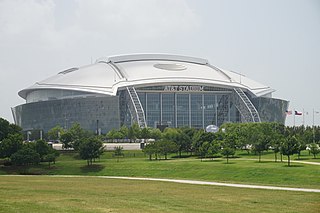
Arlington is a city in Tarrant County, Texas, United States. It is part of the Mid-Cities region of the Dallas–Fort Worth–Arlington metropolitan statistical area, and is a principal city of the metropolis and region. The city had a population of 394,266 in 2020, making it the second-largest city in the county after Fort Worth and the third-largest city in the metropolitan area, after Dallas and Fort Worth. Arlington is the 50th-most populous city in the United States, the seventh-most populous city in the state of Texas, and the largest city in the state that is not a county seat.
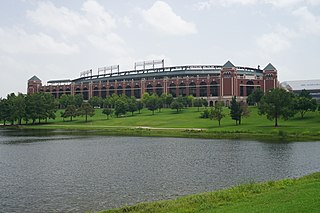
Choctaw Stadium, formerly Globe Life Park, is an American multi-purpose stadium in Arlington, Texas, United States. The venue opened in April 1994 as a baseball stadium with the name The Ballpark in Arlington, serving as the home for the Texas Rangers of Major League Baseball from 1994 through 2019. It replaced the nearby Arlington Stadium, and was succeeded by Globe Life Field.
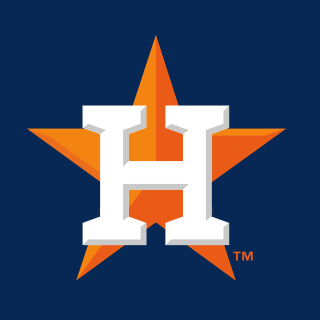
The Lone Star Series is a Major League Baseball (MLB) rivalry featuring Texas' two major league franchises, the Houston Astros and Texas Rangers. It is an outgrowth of the "natural rivalry" established by MLB as part of interleague play as the Rangers are a member of the American League (AL) and the Astros were a member of the National League (NL) until 2012. During interleague play, the winner of the six-game series was awarded the Silver Boot, a 30-inch (760 mm) tall display of a size 15 cowboy boot cast in silver, complete with a custom, handmade spur. If each team had won three games each for a tie, the declared winner was the team that scored the most runs over the course of the series. In 2013, the Astros joined the American League West with the Rangers and changed their rivalry from an interleague to an intradivision contest. The rivalry, which was once dormant, has become far more heated in recent seasons. From 2013 to 2022, 19 games were played each season. Beginning in 2023, the teams play each other 13 times a year.

Tommy Joe Vandergriff was a politician from Texas. He served as Mayor of Arlington from 1951 to 1977, as a U.S. Representative from Texas's 26th congressional district from 1983 to 1985, and as County Judge of Tarrant County from 1991 to 2007. For the greater part of his life, Vandergriff was a Democrat, but he became a Republican around 1990.
Burnett Field, in Dallas, Texas, was home to several minor league baseball clubs from 1924 to 1964. The ballpark sat 10,500 fans. It was located at 1500 East Jefferson Boulevard, Brazos Street ; Colorado Boulevard ; and the Trinity River.
The Dallas Rangers were a high-level minor league baseball team located in Dallas, Texas from 1958 to 1964. The team was known by the Dallas Rangers name in 1958, 1959, and 1964 and as the Dallas-Fort Worth Rangers from 1960 to 1963. It played in the Double-A Texas League in 1958, the Triple-A American Association from 1959 to 1962 and the Triple-A Pacific Coast League in 1963 and 1964. Its home stadium was Burnett Field.
The Dallas–Fort Worth Spurs were an American minor league baseball team in the Texas League from 1965–1971. The team played in Turnpike Stadium in Arlington, Texas.

The 1995 Major League Baseball All-Star Game was the 66th playing of the midsummer classic between the all-stars of the American League (AL) and National League (NL), the two leagues comprising Major League Baseball. The game was held on July 11, 1995, at The Ballpark in Arlington in Arlington, Texas, the home of the Texas Rangers of the American League. It was the first All-Star Game held in the Dallas-Fort Worth area, but not the first hosted by the franchise.
The Texas Rangers finished the 2004 season, third in the American League West. Five Rangers were All Stars, Francisco Cordero, Kenny Rogers, Hank Blalock, Michael Young and All-Star Game MVP Alfonso Soriano.
The Texas Rangers1993 season involved the Rangers finishing second in the American League West with a record of 86 wins and 76 losses. Before the 1993 season, Nolan Ryan announced his retirement, effective at the end of that season. It would also be the team's final year at Arlington Stadium before moving to The Ballpark in Arlington.
In the 1990 season, the Texas Rangers finished third in the American League West, with a record of 83 wins and 79 losses.
The 1971 Washington Senators season involved the Senators finishing fifth in the American League East with a record of 63 wins and 96 losses (.396). This was the Senators' 11th and last season in Washington, D.C.; they moved to Arlington, Texas, and became the Texas Rangers in 1972. The previous Senators were in Washington from 1901 through 1960.
Texas is home of several national sports league franchises among other professional sports, being the second most populated U.S. state. Since the state is located in the South Central United States, most teams are part of the Central / South or West league divisions, with the notable exception of the NFL Dallas Cowboys, which is an NFC East franchise.

The Texas Rangers Major League Baseball (MLB) franchise was established in 1961 as the second incarnation of the Washington Senators, an expansion team awarded to Washington, D.C., after the old Washington Senators team of the American League moved to Minnesota and became the Twins. The new Senators remained in Washington through 1971 playing at Griffith Stadium in their first season and at RFK Stadium for the next 10 years. In 1972, the team moved to Arlington, Texas, where it became the Texas Rangers. The Rangers played at Arlington Stadium from 1972 to 1993. Arlington Stadium was demolished, and the new Ballpark at Arlington was built, opening in 1994. The Ballpark at Arlington was renamed Globe Life Park in Arlington in 2014.

The city of Dallas and the Dallas metropolitan area are home to teams in six major sports: the Dallas Cowboys, Dallas Mavericks, Texas Rangers, Dallas Stars, FC Dallas, and Dallas Wings.
The following is a timeline of the history of the city of Arlington, Texas, USA.

Globe Life Field is a retractable roof stadium in Arlington, Texas, United States. It is the ballpark of Major League Baseball's Texas Rangers. It is located just south of the Rangers' former home ballpark, Globe Life Park.
